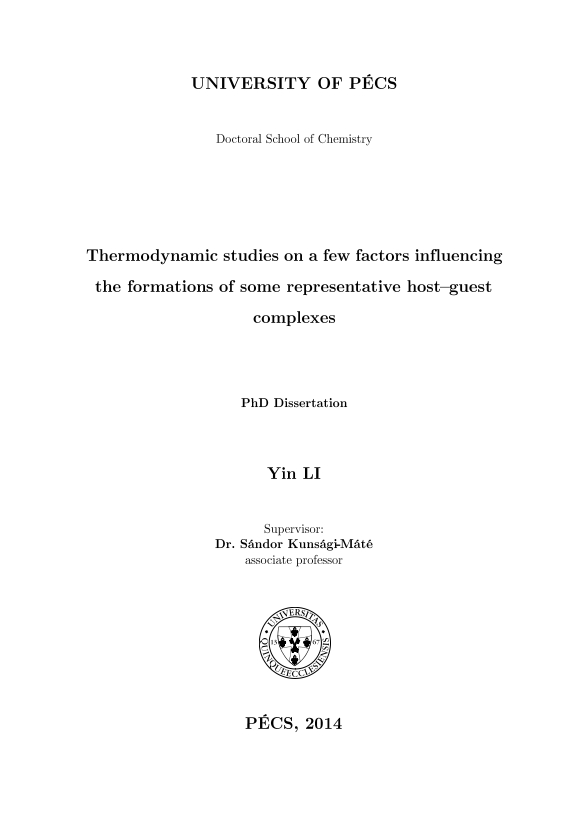Thermodynamic Studies on a Few Factors Influencing the Formations of Some Representative Host-Guest Complexes
Abstract
Crown ethers and calixarenes are two kinds of macrocyclic ligands which are able to
form complex with cations, anions and neutral species due to the non-covalent interac-
tions such as cation{dipole interaction, hydrogen bonding and p{p interaction. For a
practical purpose, understanding the nature of their sensitivity and selectivity towards
guests is of great importance. In this dissertation, several factors including conforma-
tional freedom of the skeleton of the host, solvent effect and desolvation effect of the
guest, which play important roles on host{guest interaction, were examined by using
UV{Vis spectroscopy and
uorescence emission spectroscopy. Thermodynamic param-
eters derived from the van't Hoff equation were used for the discussion of background.
Below are the summaries of the above-mentioned results.
The interactions of dimethyl-pyridino-18-crown-6 ether (`
exible' crown ether) and
dimethyl-diketo-pyridino-18-crown-6 ether (`rigid' crown ether) with K?? were studied
as a model of the effect of skeleton freedom of host molecule on host{guest interaction
by using UV{Vis spectroscopy. The results show that more negative entropy change
were obtained during the complexation of `
exible' crown ether with K?? compared to
that of `rigid' crown ether with K??. Based on theoretical calculation, this property
could probably be attributed to the different variations of vibrational modes of the
crown ether's skeleton upon the capturing K??.
The interactions of dimethyl-pyridino-18-crown-6 ether (M2P18C6) with Na?? and
K?? were investigated in methanol, ethanol and n-propanol. A correlation between
the permittivity of the solvent and the thermodynamic parameters was found. As the
permittivity of solvent decreases, the enthalpy change and the entropy change become
less favorable and more favorable, respectively. A correlation between thermodynamic
parameters and the permittivity of solvent was obtained. Enthalpy{entropy compen-
sations were observed both in M2P18C6{K?? and M2P18C6{Na?? complexations. In
order to understand this phenomenon, a two-step complexation model including both
classic hydrophobic effect (step 1) and non-classic hydrophobic effect (step 2) was pro-
posed. As the solvent varies from methanol to n-propanol, both the hydrophilicity of
i
the solvent and the number of the released solvent molecules decrease. As a result,
the classical hydrophobic effect plays more important role than the non-classical hy-
drophobic effect in complexations. The complexation becomes a mainly entropy-driven
process in n-propanol.
Solvent effect on the host{guest interaction is investigated on a human serum albu-
min (HSA){ochratoxine A (OTA) interaction. Buffer{ethanol mixture is used in this
study because ethanol is a commonly used solvent in biological processes. Ethanol is
found to have an inhibition effect on the binding of OTA to HSA. Thermodynamic
study show that an increasing amount of ethanol leads to a switch from being entropy-
driven to enthalpy-driven of HSA{OTA interaction. The observed enthalpy{entropy
compensation can be attributed to the shift of the dominant role in complexation from
the classical hydrophobic effect to the non-classical hydrophobic effect, arising from the
more enhanced hydrogen bond network in the bulk phase as the ethanol concentration
increases.
The interactions of a resorcinarene and its derivative|cavitand with alkali metal
ions including Li??, Na??, K?? and Cs?? in methanol were investigated by using steady-
state
uorescence technique. Thermodynamic parameters show that complexations of
resorcinarene with Li?? and Na?? are enthalpy-driven processes, while those of cavitand
with K?? and Cs?? are entropy-driven processes. According to their thermodynamic
behaviors, two different binding mechanisms, namely the binding of methanol-solvated
Li? and Na?? to the cavity of resorcinarene, while the binding of desolvated K?? and
Cs?? to the cavity of cavitand, were proposed.
The interaction of a novel `three-level' deepened cavitand with some transition metal
ions has been investigated using
uorescence quenching technique. The results show
that among the used transition metal ions including Ag??, Cd2??, Cu2??, Fe3??, Cr3??,
Hg2??, La3??, Mn2?, Ni2??, Zn2?? and Co2??, only Fe3?? and Cu2?? possess good quenching
efficiency on the emission intensity of this cavitand. The simultaneous presence of the
sphere-of-action static quenching and dynamic quenching model interprets very well
the observed decrease of emission intensity of the cavitand quenched by both Fe3?? and
Cu2??.

